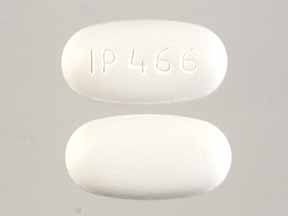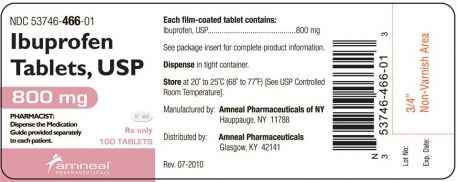Contents
- What is IP 466 white pill?
- Active ingredient of IP 466 pill and its identification
- IP 466 pill chemistry
- IP 466 pill uses
- IP 466 white pill legal status
- What are different brand names for ibuprofen?
- IP 466 pill price and prescription
- IP 466 pill mechanism of action
- IP 466 pill side effects
- IP 466 pill pharmacokinetics
- How long IP 466 stays in the system?
- IP 466 safety of use
What is IP 466 white pill?
IP 466 is an imprint on a pill identified as white in an capsule shape. Pill contains ibuprofen in dose of 800 mg. Ibuprofen belongs to the drug class nonsteroidal anti-inflammatory agents and is used for the treatment of toothache, back pain; sciatica; headache; gout, acute pain and others. It is supplied by Amneal Pharmaceuticals.

- Imprint: IP 466
- Strength: 800 mg
- Color: White
- Size: 19.00 mm
- Shape: Capsule-shaped
- Availability: Rx and/or OTC
- Drug Class: Nonsteroidal anti-inflammatory agents
- Pregnancy Category: C – Risk cannot be ruled out – prior to 30 weeks gestation
- D – Positive evidence of risk – starting at 30 weeks gestation
- CSA Schedule: Not a controlled drug
- Labeler / Supplier: Amneal Pharmaceuticals
- Other Labelers / Repackagers: AvKare, Amerisource Health Services, McKesson Packaging Services, A-S Medication Solutions, LLC (repackager), A-S Medication Solutions, LLC (repackager), Nucare Pharmaceuticals Inc. (repackager).
- Inactive Ingredients: crospovidone, magnesium stearate, microcrystalline cellulose, povidone, corn starch, silicon dioxide, stearic acid
Active ingredient of IP 466 pill and its identification
Ibuprofen 800mg tablets contain the active ingredient ibuprofen, which is (±) – 2 – (p – isobutylphenyl) propionic acid.
Ibuprofen is a white powder with a melting point of 74-77° C which is very slightly soluble in water (<1 mg/mL) and readily soluble in organic solvents such as ethanol and acetone.
IP 466 pill chemistry
Ibuprofen:
IUPAC name: 2-[4-(2-methylpropyl)phenyl]propanoic acid
Molecular formula: C13H18O2
Molecular weight: 206.285 g/mol
Molecular structure:
Drug class: This compound belongs to the class of organic compounds known as phenylpropanoic acids. These are compounds with a structure containing a benzene ring conjugated to a propanoic acid.
IP 466 pill uses
Following indications for ibuprofen are FDA approved:
- Ankylosing Spondylitis (AS)
- Cystic Fibrosis (CF)
- Fevers
- Gout Acute
- Headaches
- Juvenile Idiopathic Arthritis (JIA)
- Menstrual Cramps
- Migraines
- Osteoarthritis (OA)
- Patent Ductus Arteriosus (PDA)
- Pericarditis
- Primary Dysmenorrhoea
- Rheumatoid Arthritis
- Severe Pain
- Mild Pain
- Mild Pain NOS
- Moderate Pain
IP 466 white pill legal status
It is legal to poses ibuprofen 800 mg in the US. This drug is classified as OTC or prescription drug.
What are different brand names for ibuprofen?
Different brand names for ibuprofen are: Motrin, Nurofen, Brufen, Nuprin, Rufen, Advil, Dolgit.
IP 466 pill price and prescription
OTC brands include Advil and Motrin. The lowest GoodRx price for the most common version of ibuprofen is around $7.14, 81% off the average retail price of $38.37.
IP 466 pill mechanism of action
The exact mechanism of ibuprofen action is yet unknown. It is known that this drug is a non-selective inhibitor of COX, an enzyme invovled in prostaglandin synthesis through the arachidonic acid pathway. It is believed that it exhibits its pharmacological effects due to inhibition cylooxygenase-2 (COX-2) which decreases the synthesis of prostaglandins involved in mediating inflammation, pain, fever and swelling.
Antipyretic effects may be caused by the action on the hypothalamus, which may result in an increased peripheral blood flow, vasodilation, and subsequent heat dissipation. Inhibition of COX-1 is thought to cause some of the side effects of ibuprofen including GI ulceration.
Ibuprofen is used as a racemic mixture. The R-enantiomer undergoes extensive interconversion to the S-enantiomer in vivo. The S-enantiomer is believed to be the more pharmacologically active enantiomer.
IP 466 pill side effects
Ibuprofen may cause following side effects:
Common side effects:
- Stomachache
- Heartburn
- Dizziness
- Rash
- Drowsiness
- Nausea
- Vomiting
- Constipation
- Ringing in the ears
Serious side effects:
- Liver failure or inflammation of the liver
- Low platelet count
- Blood in the urine
- Urinary tract infection
- A condition in which the bone marrow is unable to make enough white blood cells, known as agranulocytosis
- Low red blood cell count, or anemia
- Severe and potentially life-threatening skin reactions such as Stevens-Johnson Syndrome or toxic epidermal necrolysis (TEN)
- Stroke
- Heart attack
- High blood pressure
- Kidney damage
IP 466 pill pharmacokinetics
- Absorption: About 80% of drug is absorbed from GI tract. Time to reach peak plasma is about 120 minutes.
- Distribution: Ibuprofen appears to bind in 90-99% to whole human plasma and site II of purified albumin. It appears to be saturable and becomes non-linear at concentrations exceeding 20 mcg/ml.
- Metabolism: R-enanatiomer of ibuprofen undergoes extensive enantiomeric conversion (53-65%) to the more active S-enantiomer in vivo. Metablized by oxidation to 2 inactive metabolites: (+)-2[4´-(2-hydroxy-2 methylpropyl)phenyl]propionic acid and (+)-2-[4´-(2-carboxypropyl)phenyl]propionic acid. Very small amounts of 1-hydroxyibuprofen and 3-hydroxyibuprofen have been recovered from urine. Cytochrome P450 2C9 is the major catalyst in the formation of oxidative metabolites. Oxidative metabolites may be conjugated to glucuronide prior to excretion.
- Elimination: Ibuprofen is rapidly metabolized and eliminated in the urine. Elimination hal-life time is 2-4 hours.
How long IP 466 stays in the system?
Ibuprofen has intensive metabolism in most cases and is expelled through urination quickly, too. It elimination half live time is 2-4 hours. Because of that, ibuprofen usually stays in the system for only 24 hours.
Because the drug metabolizes so quickly, there have been no data made about the duration the medication stays in your urine, blood or hair for purposes of drug tests. Since it is absorbed into the body so fast and eliminated quickly, it is believed that the medicine won’t be detectable after a full day.
IP 466 safety of use
Cardiovascular Risk
- Ibuprofen may cause an increased risk in predisposed patients provoking serious cardiovascular thrombotic events, myocardial infarction, and stroke, which can be fatal. This risk may increase with duration of use. Patients with cardiovascular disease or risk factors for cardiovascular disease may be at greater risk
- Ibuprofen tablets are contraindicated for treatment of peri-operative pain in the setting of coronary artery bypass graft (CABG) surgery.
Gastrointestinal Risk
- Ibuprofen may cause an increased risk of serious GIT adverse events including bleeding, ulceration, and perforation of the stomach or intestines, which can be fatal. Such effevts can occur at any time during use and without warning symptoms. Elderly patients are at greater risk for serious gastrointestinal events.
“M366 pill identifier”
Is it safe to take Tylenol and ibuprofen together?“
“Can I use ibuprofen after expiration date?“
“Is it safe to take ibuprofen with Vicodin?“


